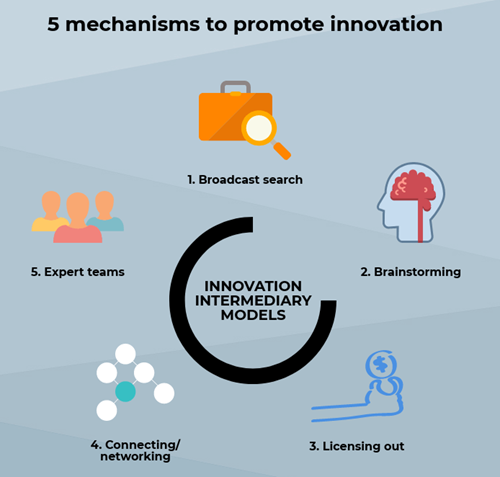- Innovation
5 Key Drivers of Innovation
How can companies accelerate their ability to innovate?
ESADE innovation expert Esteve Almirall and his research colleague Tuba Bakici at the ESC Rennes School of Business have identified 5 key drivers to help companies innovate.
Their research findings, published in the Journal of Business Strategy, reveal how innovation intermediaries – a new set of emerging actors – can help companies boost their innovation.
“Innovation intermediaries build their business by connecting the problems and needs of organizations (seekers) with a community of potential solvers who act as facilitators,” says Professor Almirall. “Innovation intermediaries can considerably reduce the companies’ transaction costs related to research and bargaining while helping them tap into markets for intellectual property and external expertise.”
The potential benefits of these emerging actors are promising. But how can companies select the innovation intermediary that best matches their needs? Failure is part of the process, the authors warn.
Failed attempts
“A striking example of this matching challenge is the failure of British Petroleum’s open innovation initiative with InnoCentive, an innovation intermediary that generated over 1,000 proposed solutions to help contain the Gulf oil spill,” explains Almirall. “The solutions, which were submitted in a closed form, lacked the necessary review and filtering process, as well as the recombination of these ideas by the community itself.”
BP decided not to pursue any of InnoCentive’s suggestions, as they defined the examination process as burdensome.
The 5 mechanisms to promote innovation
To address these matching challenges, the authors analyzed 51 innovation intermediaries by conducting interviews with managers and researchers, including the directors of four innovation intermediaries (Atizo, dotOpen, Innoget and Nokia’s IdeasProject).
The authors identified the following 5 distinct innovation intermediary models that can help companies boost innovation:

1. Broadcasting
The most common matching mechanism type is broadcast search, which involves publishing the innovation request as a challenge to a vast audience in the hope that responses will reveal that someone has developed a solution in other contexts, or that someone is willing to develop a solution.
For instance, NASA broadcasted its need for solutions to utilize surface-based materials like basalt rock in a novel way for construction in space to support exploration. The solution, received from a university professor in less than four months, not only increased the feasibility of space exploration but, at only $15,000, was also cost-effective.
The findings reveal that the role of innovation intermediaries in this type of broadcast search is crucial for requests that are highly specific and technical and require solution development.
2. Brainstorming
Broadcast search can work well when a clearly defined problem or need exists, but many organizational problems and needs are poorly defined, especially during the exploratory phase, such as when the organization is considering new design ideas or trends, finding a slogan or seeking to increase shares in social media.
One mechanism that addresses these particular situations is brainstorming, which generates a diverse set of ideas in a scalable setting for solvers. In this method, the community creates and posts ideas openly on a platform and filters these ideas through voting or feedback.
The intermediaries act as a forum-like platform where ideas and solutions are generated openly and collaboratively.
3. Licensing out
Rather than seeking possible solutions, companies and community members can post relinquished solutions to seek potential adopters that may find them of value. This is precisely the objective of the licensing out mechanism: to create a web-based technology bazaar for matching technology developers with potential investors.
Although licensing out is similar to broadcast search, the two mechanisms differ in one crucial way: with licensing out, companies do not look for solutions but for relevant leads that can eventually use extant solutions in new contexts.
In working with an intermediary, such as Innoget or yet2.com, companies and individuals publish their available know-how in the form of market-ready patents, innovative products and technologies to a community with the aim of licensing them out to commercialize.
4. Connecting/networking
Ideas, market-ready products and technologies are undoubtedly significant, but companies recognize that developing their networks without an immediate objective is also important. For this reason, beyond looking for solutions, organizations may benefit from building communication within their ecosystems to develop opportunities for collaboration and partnerships.
Within such collaborative intermediary platforms, organizations can discover and contact potential investors, start-ups, partners and customers by creating a profile of their interests and projects. One example of these intermediaries is dotOpen, which works more or less like LinkedIn for companies by allowing decision-makers to research, discover and contact potential clients, competitors, investors, suppliers and other partners.
5. Expert teams
While endogenous team collaborations can evolve by themselves to further develop ideas, intermediaries can also foster expert groups either by selecting group members from the community or by hiring group members for a position in the group.
Studies indicate that expert teams have always shown themselves to be important in the innovation creation process. Ideas to Go and NineSigma are examples of intermediaries offering this type of matching mechanism.
Often this mechanism is used to harness the expertise of the community to solve well-defined but complex problems or tasks such as building a prototype or solving a biomedical problem.
Access the original research paper: ‘Intervention intermediaries flourish: matching firms with solutions to complex needs’, Esteve Almirall, Tuba Bakici, (2017) Journal of Business Strategy, Vol. 38 Issue: 4, pp.21-29.
ESADE Business School, since its inception in 1958, is one of the world's most prestigious business schools, and has become a frame of reference in the world of executive training.
ARTICLES YOU MIGHT LIKE
VIEWPOINT
Cognitive neuroscientist, Lynda Shaw, explains how to understand and support intrapreneurs
DEVELOPING LEADERS QUARTERLY MAGAZINE AND WEEKLY BRIEFING EMAILS


































